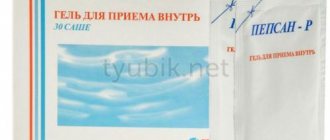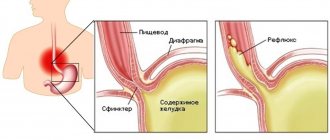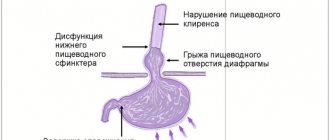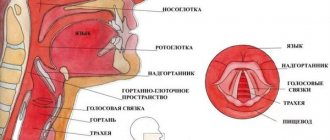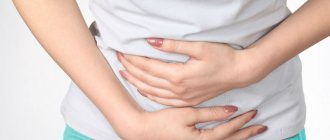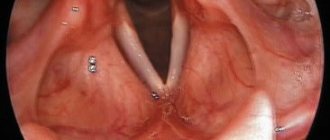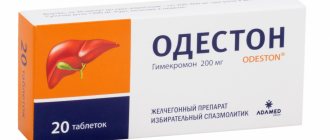Pain in the upper chest, burning and frequent heartburn are signs of esophagitis. This is a disease that occurs due to the release of fragments of stomach contents into the esophagus.
- Reflux esophagitis: symptoms
- Reflux esophagitis: treatment, drugs
- Reflux without pathology
Not everything is so simple with prokinetics for GERD.
In this article I will try to explain why...
The final impetus for me was a discussion published in the pages of the Journal of Pediatric Gastroenterology and Nutrition (JPGN) after an article published in the November 2022 issue
Does Combined Multichannel Intraluminal Impedance and pH (MII-pH) Testing Improve Clinical Outcomes in Children With Gastroesophageal Reflux Disease?
The authors of this article selected treatment for children based on the results of daily impedance pH measurements, including prokinetics in the treatment regimen.
In June 2022, in the letters to the editor section, a message appeared from one of the subscribers “Prokinetics in Childhood Gastroesophageal Reflux Disease: Are They Indicated?”, which raised the question of the place of prokinetics in the treatment of GERD in children.
Dissatisfied subscribers pointed out the non-standard approach to the treatment of GERD by the authors of the original article.
In some ways they are right.
The NASPGHAN (North American Society For Pediatric Gastroenterology, Hepatology & Nutrition) guideline states that the available evidence is insufficient to support the routine use of prokinetic agents for the treatment of GERD in children.
For example, the expert authors of the guideline found only 4 randomized clinical trials on domperidone for GERD, which did not convincingly demonstrate benefit for GERD in children.
In addition, it emphasizes that side effects from the nervous system are possible.
An excellent 2022 book, Gastroesophageal Reflux in Children 2022, edited by Yvan Vandenplas, says this:
The reasons for GERD's poor response to treatment are complex, and the use of anti-acid medications may not be the answer for all patients.
Prokinetics may have potential in the treatment of GERD, at least in some special groups of patients.
Domperidone accelerates gastric motility and the release of food from it, thereby reducing the number of refluxes that occur after eating.
Meanwhile, the prokinetic agents available to us have side effects that outweigh their potential benefits for the treatment of GERD. More research is needed to evaluate their effectiveness and safety.
Children are especially susceptible to the side effects of domperidone due to immaturity of the nervous system and increased permeability of the blood-brain barrier (the filter between the blood and the fluids that bathe the brain, necessary to protect the brain from toxins).
New or worsening colic and general irritability have been described in infants.
Typical manifestations:
- the desire to constantly clear your throat, especially in the morning or after eating
- persistent dry (no phlegm) cough
- sore throat outside of acute respiratory infections
- hoarseness
- feeling of a foreign body in the throat.
A little more about the main manifestations of laryngopharyngeal reflux.
Laryngitis is one of the common manifestations of LPR.
A condition well described by otolaryngologists.
Although laryngopharyngeal reflux is quite common, it is not the only cause of laryngitis.
Otolaryngologists always rule out postnasal drip, allergies, and irritants from inhaled air (including tobacco smoke from active or passive smoking).
Reflux and chronic cough.
Probable reasons:
- The esophagus and bronchial tree have a common embryonic origin and innervation. Irritation of neuroreceptors in the esophagus and throat can activate the reflex arc and provoke bronchospasm. Moreover, to trigger the reflex, throwing it into the lower part of the esophagus, right next to the stomach, may be enough.
- Direct reflux into the respiratory tract. The mechanism is controversial, since studies have been conducted on the frequency of detection of pepsin (an enzyme in gastric juice) and bile acids in bronchoalveolar fluid, and no difference was found in people with and without a cough.
The connection between reflux and long-term nasal congestion and chronic postnasal drip , an unpleasant condition in which there is a constant sensation of drainage down the back of the throat, is being actively studied.
There is a possible connection between reflux and halitosis - bad breath, disturbances in the perception of tastes and smells.
Getting stomach contents into the ear can cause otitis media, ringing or noise in the ears, and dizziness.
Domperidone may cause side effects:
- neurological disorders such as oculogyric crisis - involuntary movement of the eyeballs
- hyperprolactinemia , that is, increased levels of the hormone prolactin; this hormone stimulates milk production in women after childbirth, but is definitely not needed in such quantities for a child
We have already discussed that most babies who spit up do not need treatment at all , and only those children who have additional problems require attention, such as irritability and restlessness, which is believed to be associated with irritation of the esophagus by acid.
Accordingly, if we start treating such a restless baby with domperidone for GERD, there is a high chance of even increasing the child’s anxiety and completely confusing everything.
Also, an unpleasant thing has been noticed with domperidone - it can increase the likelihood of life-threatening heart rhythm disturbances.
The main statistics on such complications appeared back when intravenous domperidone was used in high doses, and most of the victims were elderly people, not children.
I should tell you a little about domperidone as the most popular of prokinetics.
Reflux esophagitis: symptoms
The symptoms of GERD have their own specificity, which is why making a diagnosis, as a rule, does not require a large number of examinations and tests. However, to exclude the infectious nature of chest pain, the doctor may prescribe a number of tests.
Typical reflux symptoms include:
- heartburn;
- pain in the heart area,
- sensation of a lump in the throat, making it difficult to swallow.
Infrequent symptoms that require additional examination include:
- hoarseness of voice;
- frequent inflammatory processes in the upper respiratory tract;
- dry cough.
Due to the fact that the structure of the respiratory system is closely connected with the esophagus, the release of acid from the stomach can reach the vocal cords and even the tonsils. Therefore, when a patient complains of unexplained hoarseness or a frequent, irritating dry cough, it is worth paying attention to the condition of the upper gastric sphincter. In the absence of additional symptoms of ARVI (runny nose, fever, general weakness), it is necessary to undergo examination by a gastroenterologist.
Domperidone
Domperidone was synthesized in 1974 by Janssen Pharmaceutica during the search for antipsychotic drugs.
It has been noted that some antipsychotic drugs that act on receptors for the nervous system neurotransmitter dopamine also reduce nausea and vomiting.
Domperidone turned out to be a drug that relieved nausea well, but had minimal effects on the brain and, accordingly, had almost no side effects typical of other drugs.
In the late seventies they began to bring it to the market
It became popular in many countries, although its indications may differ from country to country. In some countries it can be purchased without a doctor's prescription.
A surge in discussion about domperidone arose in 2013-2014, when statistics appeared about an increase in the risk of life-threatening cardiac arrhythmias, primarily in older people.
Even earlier, in 1985, the injectable form was discontinued due to these side effects.
Side effects were rare, and the drug was not completely withdrawn from the market, but as a result, in 2014, European Union regulators recommended changing approaches to prescribing domperidone.
- Use specifically to treat nausea and vomiting
- Limit dose to 10 mg up to 3 times daily for adults and adolescents weighing more than 35 kg.
- For use in children weighing less than 35 kg, the recommended dose is 0.25 mg per kilogram of weight up to 3 times a day.
- Use no more than 1 week
- Remove combination drugs, for example, with cinnarizine for motion sickness.
The Russian market still uses broader indications for domperidone:
- a complex of dyspeptic symptoms, often associated with delayed gastric emptying, gastroesophageal reflux, esophagitis:
- feeling of fullness in the epigastrium, early satiety, feeling of bloating, pain in the upper abdomen;
- belching, flatulence;
- nausea, vomiting;
- heartburn, regurgitation of gastric contents or without it;
- nausea and vomiting of functional, organic, infectious origin caused by radiotherapy, drug therapy or diet disorders;
- nausea and vomiting caused by dopamine agonists when used in Parkinson's disease (such as levodopa and bromocriptine).
The Janssen company itself, the manufacturer of Motilium, does not forget to warn:
Domperidone-containing drugs are contraindicated:
- patients with moderate and severe liver failure;
- patients with cardiac rhythm and conduction disturbances (especially QT segment prolongation) and patients with severe electrolyte disturbances or heart disease, such as congestive heart failure;
- when used together with drugs that cause prolongation of the QT interval;
- when used together with strong CYP3A4 inhibitors (regardless of their QT-prolonging effect).
Letter from Roszdravnadzor on this topic
Reflux esophagitis: what is it?
The diagnosis of reflux esophagitis is made when repeated episodes of gastric contents reflux into the esophagus are detected. As a result, the walls of the esophagus are burned by gastric acid, erosion occurs and an inflammatory process develops. According to official statistics, more than 45% of the population suffers from this problem, but only 13% of them seek help from specialists. And among those who applied, only 7%-10% return to a normal lifestyle, which is due to low literacy of the population.
Often patients do not follow the doctor’s recommendations and stop adhering to the chosen course of treatment and nutritional schedule. Because of this, all treatment comes to naught and the problem returns.
Gastric juice is an extremely aggressive environment based on hydrochloric acid. Its goal is to destroy all pathogenic flora that enters the stomach. If it comes into contact with the delicate mucous membrane of the esophagus, it can cause serious chemical burns, which then heal, covering the walls with scar tissue.
So are prokinetics useless for treating GERD?
Such a statement is too categorical.
These are not the main drugs, but quite useful.
There are good statistics on the treatment of GERD in adults.
A recent meta-analysis of 14 studies, including data from 1437 patients, showed that the addition of a prokinetic agent to proton pump inhibitor treatment relieves GERD symptoms and improves quality of life, but does not affect the healing of esophageal erosions as measured by EGD.
A very recent meta-analysis published in 2022 on data from 16 studies also confirmed that adding prokinetics to proton pump inhibitors reduces GERD symptoms
Diagnosis of laryngopharyngeal reflux.
Questionnaires
One of the easiest ways to assess the likelihood of laryngopharyngeal reflux.
The version presented below contains nine complaints, each of which is rated by severity from 0 (nothing) to 5 (very pronounced).
More than 13 points – LFR is assumed.
from herehttps://scitemed.com/article/2594/Laryngopharyngeal-Reflux-An-Update
Laryngoscopy.
The bottom line is that using a flexible tube (laryngoscope), an otolaryngologist evaluates signs of irritation of the windpipe by stomach contents. Laryngoscopy allows you to see a lot, but the accuracy of the method is not ideal. A lot depends on the experience of the particular doctor.
To increase diagnostic accuracy, it is proposed to evaluate the results of laryngoscopy using the Reflux Finding Score.
Eight endoscopic signs with severity ranging from 0 to 2 points are assessed.
from herehttps://scitemed.com/article/2594/Laryngopharyngeal-Reflux-An-Update
Daily monitoring of reflux.
This test is the gold standard for diagnosing GERD. A thin probe is placed into the esophagus, which records fluctuations in acidity, and ideally also fluctuations in resistance (this is how alkaline and gas reflux are detected). Monitoring data can be compared over time and with specific complaints (feeling of heartburn, sudden sore throat, coughing attack, etc.)
The method is very useful for diagnosing LPR, but its active use is limited by low availability and high cost.
In Yekaterinburg there is only one center that carries out daily pH-impedance monitoring.
Fibrogastroduodenoscopy and radiography of the esophagus and stomach are of little importance for the diagnosis of LPR, although they are actively used for the management of classic GERD.
Ultrasound of the stomach
Prescribed by pediatricians, otolaryngologists, and gastroenterologists of our city. Why is not clear.
I’ll just give a link to the post in which I already discussed this method https://konobeitsev-md.ru/diagnostika-gastrojezofagalnoj-refljuksnoj-bolezni/
There is no need to do this examination to diagnose reflux!
Our services
The administration of CELT JSC regularly updates the price list posted on the clinic’s website. However, in order to avoid possible misunderstandings, we ask you to clarify the cost of services by phone: +7
| Service name | Price in rubles |
| Gastroscopy (videoesophagogastroduodenoscopy) | 6 000 |
| Colonoscopy (video colonoscopy) | 7 000 |
| Ultrasound of the abdominal organs (liver, gall bladder, pancreas, spleen) | 3 800 |
| Fluoroscopy and radiography of the stomach | 4 800 |
All services
Make an appointment through the application or by calling +7 +7 We work every day:
- Monday—Friday: 8.00—20.00
- Saturday: 8.00–18.00
- Sunday is a day off
The nearest metro and MCC stations to the clinic:
- Highway of Enthusiasts or Perovo
- Partisan
- Enthusiast Highway
Driving directions
